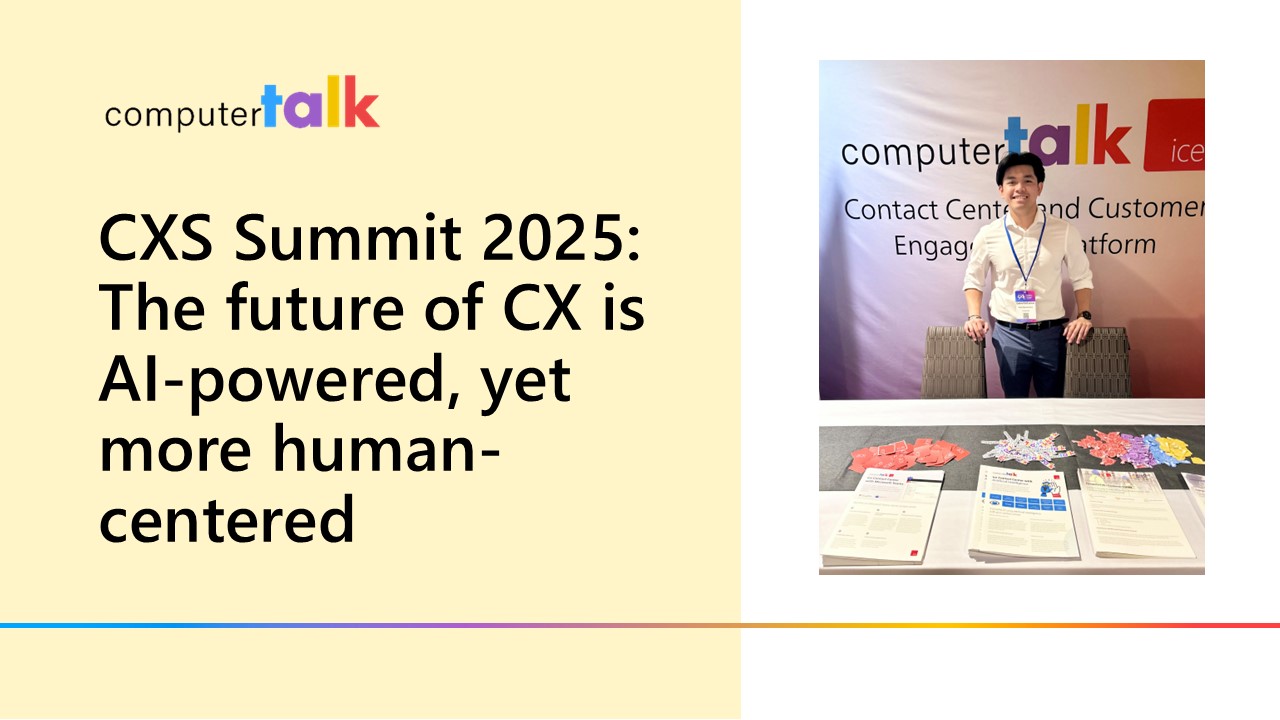Why Your Contact Center is Losing Customers (and How to Fix It)
by Gabriel De Guzman | Published On November 25, 2025

Customers don’t always warn you when they’re unhappy. They can just stop calling, cancel a subscription, or choose an alternative option. The signs show up in more abandoned calls, fewer repeat orders, and lower satisfaction scores.
It doesn’t take much to trigger that exit. One drawn-out hold, a chatbot that goes in circles, or an agent who sounds lost because the system hides the customer’s history is enough. People leave faster than most companies expect. Emplifi found that seven out of ten consumers move on after two poor service experiences, and nearly one in four switch brands after only one.
People now want quick answers; smooth movement between chat, email, and phone; and support that actually feels personal. When systems lag or feel disconnected, frustration grows. Reviews and social posts spread the story long before churn shows up in reports.
Many contact centers make this worse without realizing it; agents jump between too many tools, routing rules leave callers waiting or bouncing between queues, bots get in the way instead of helping, and tech glitches break conversations. Each weak spot makes it easier for a customer to hang up and never come back.
Spotting those weak points early is critical. Once they’re clear, you can start fixing what drives people away and rebuild trust before it’s gone.
The Common Reasons Contact Centers Lose Customers
Once you start looking closely, the same trouble spots appear in most support operations. Some are obvious, like long waits. Others hide in the background until you dig into call recordings or agent dashboards. Two of the biggest churn drivers show up early: time spent waiting and the tangle of tools agents use.
1. Long wait times and abandoned calls
No one enjoys sitting in a queue. When hold music drags on, patience runs out fast. Industry targets still point to the 80/20 goal - answering 80% of calls in 20 to 28 seconds and keeping abandonment below 5%.
Digital channels aren’t immune. In chat and messaging, people often leave without saying goodbye. Researchers have found silent abandonment rates between 30% and 67% in these channels. Agents may keep typing while the customer is long gone.
The causes are usually predictable: staffing gaps during peak times, outdated routing that sends callers down the wrong path, and no callback or virtual hold option. The complexity of calls has also changed. Simple questions are often handled by self-service or bots. The calls that reach agents now tend to be harder and take longer to resolve, which clogs queues and drives more hang-ups.
2. Limited support channels and fractured journeys
Nobody sticks to one way of talking to a company anymore. A customer might start a chat during lunch, reply by email when work gets busy, then pick up the phone after hours if it’s still not fixed. They assume you’ll keep up and remember the whole conversation.
Many contact centers still fall short here. Some only offer phone and email. Others have added chat or social channels but keep them siloed. When systems don’t share data, customers repeat themselves every time they switch. That extra effort is frustrating and often ends with someone abandoning the interaction.
Agents feel the pain too. Without unified tools, they jump between dashboards to piece together what happened in other channels.
3. Inconsistent or poor service quality
Even when call volumes are under control, the experience can fall apart if the quality of support isn’t steady. Many centers still review only a tiny slice of interactions - sometimes one or two percent - for quality assurance.
That means most coaching happens late, after bad habits have already taken root. Without timely feedback, agents develop their own workarounds. Some may give answers that aren’t accurate. Others rely too heavily on scripts and miss the nuance of a customer’s problem.
Micro-coaching during live calls or soon after can close these gaps fast, but many operations don’t have the tools or time for it. The result is a roulette wheel of experiences: one caller gets a confident, helpful agent; the next gets someone guessing.
Inconsistent service kills trust. It forces customers to call back, explain their issue again, and hope the next person can solve it. That extra effort is a known driver of churn.
4. Overreliance on bots without an escape route
Automation helps only when it’s designed with a safety net. Too many chatbots still trap people in loops or hand them off poorly. A Harvard Business Review survey found 77% of customers describe chatbots as frustrating.
The frustration isn’t that bots exist, it’s how they’re used. Many are built to deflect rather than assist. They ask a few basic questions, fail to solve anything complex, and then make the user start over with an agent. Others don’t even offer a quick handoff when the customer types “talk to a person.”
That dead end damages trust and brand perception. People expect a smart assist that saves time. When it turns into an obstacle, they abandon the interaction and look elsewhere for help.
5. Lack of personalization and context
Customers expect companies to understand their needs and adapt to them. When they reach out to the support team, they don’t want to repeat an order number three times or start the story over with every transfer. They expect the agent to see what they’ve bought, what problems they’ve had, and any notes from past calls.
That’s not how many centers work. Customer data is often scattered across different systems. One screen shows the account, another shows tickets, and a third holds payment history. Agents end up piecing together the basics while the customer waits.
6. Outdated systems and fragile tech
Old contact center platforms slow everything down. Screens freeze, calls drop, and routing rules break when volume jumps. Each glitch adds time and stress for agents and customers.
The cost can be big. The Uptime Institute reports more than half of major IT outages cost over $100,000, and roughly one in five passes $1 million. Even smaller outages hurt - they interrupt conversations, cause repeat calls, and make the company look unreliable.
Aging systems also don’t work well with newer tools like real-time dashboards or AI that predicts call surges. Without those tools, it’s harder to keep wait times down, coach agents during calls, or recover quickly when something breaks. Customers feel every second of that lag.
How to Fix What’s Driving Customers Away
Knowing the problems is only half the job. The real test is putting the right fixes in place. The good news is that most of the issues customers complain about aren’t mysteries - they’re operational challenges that can be solved with the right mix of process, tools, and training. Two areas usually deliver the quickest wins: reducing wait times and building true omnichannel support.
1. Shorten waits with smarter routing and self-service
Long queues don’t just frustrate customers; they drain agents too. The fix isn’t only about hiring more staff; it’s about getting smarter with the staff already in place.
- Skills-based routing directs calls to the person most likely to solve the issue quickly. That alone can cut repeat transfers.
- Callback and virtual hold options let customers keep their spot in line without waiting on hold. Abandonment rates drop when people know they’ll get a return call.
- Modern IVR and voice bots can handle routine requests like balance checks or appointment confirmations. When these bots are designed well and offer a quick handoff to a live agent, they save time without blocking people.
The results can be big. Contact centers that add callback features often see abandonment fall significantly. Plus, smarter routing drives first contact resolution, which is one of the strongest predictors of loyalty.
2. Build real omnichannel support
Customers jump between channels constantly. They might start with a chat on their phone, send an email later, and call when they want a faster answer. If those channels don’t connect, the experience falls apart.
True omnichannel isn’t about offering every channel under the sun. It’s about carrying the conversation wherever the customer goes. Agents can see the history and pick up right where things stopped. No repeating. Faster fixes. It pays off - companies with strong omnichannel capabilities keep 89% of their customers. Weak ones keep only 33%. That gap says it all.
A good starting point is a single agent desktop that pulls in phone, chat, email, and social feeds. From there, reporting should move from channel-based metrics to journey-based metrics, which measure how many steps it takes to get a resolution.
3. Train and coach agents all the time, not just once
Most agents get a big burst of training when they join. Then it slowly disappears. That’s when mistakes creep in and confidence fades. Customers hear it right away - hesitation, conflicting answers, awkward silences. The real fix is steady coaching, not a one-time boot camp.
- Coach in the moment. Listening tools can flag when an agent is struggling so a supervisor can step in with quick guidance.
- Scorecards and call reviews show what “good” looks like and give agents clear goals.
- Regular refreshers keep everyone up to speed on product updates and policy changes.
Agents who feel backed up stick around and do better work. Gallup found that engaged employees are 21% more productive and far less likely to quit. Replacing just one contact center agent can cost up to double their salary once you count hiring and training. Keeping good people matters.
4. Let automation help, but keep humans easy to reach
Virtual agents and bots can be useful when they’re saving time. They become a problem when they trap people. Tips to keep in mind when using bots and automation:
- Keep them on simple jobs. Tracking orders, checking balances, or resetting passwords work well.
- Always give an easy out. A clear “talk to an agent” button or phrase should hand customers over fast.
- Pass context forward. If a bot asked for an account number or order ID, that info should show on the agent’s screen after a transfer.
When this balance is right, customers handle quick tasks themselves and reach a person fast when they need one. Satisfaction climbs because the bot speeds things up without blocking real help. Gartner predicts 80% of service teams will use AI by 2026 but warns that it backfires when people can’t reach a human easily.
5. Make service personal with live data
Customers expect you to know them. They don’t want to explain what they bought or what went wrong every time they reach out. Too often, agents see only a sliver of the story because systems don’t talk to each other.
Pulling data into one clear view changes the call. An agent who sees a customer’s past orders, tickets, and notes from previous interactions can skip asking the basic questions and focus on solving the problem. Routing rules can steer valuable accounts or urgent issues to the right person on the first try. Predictive tools can even guess the reason for a call based on recent activity.
Personalization pays off. McKinsey found companies that use personalization well drive up to 40% more revenue than competitors. For a contact center, that often means shorter calls, fewer transfers, and customers who stick around.
6. Replace fragile tech with tools that hold up
Slow, outdated systems turn every call into work; Agents wait for screens to load, calls fail when volume spikes, and reporting can take hours, so managers spot problems too late. Even small outages hurt loyalty because customers feel the slip right away.
Moving to a cloud contact center platform removes a lot of that friction. These systems scale during busy times, plug into CRM and collaboration apps, and give managers live dashboards to watch queues and fix issues fast. Automating reports and routine clicks frees agents to actually help customers.
Modern platforms also bring smarter routing, AI coaching, and deeper analytics. Centers that modernize usually see quicker answers, fewer repeat calls, and calmer agents who aren’t wrestling with clunky tools.
Why Upgrading the Contact Center Pays Off
Fixing the big pain points in a contact center doesn’t just make calls nicer but also reshapes how the whole service operation works.
- Customers stay longer: Fast, personalized service builds loyalty. Even a tiny retention boost matters - just 5% more can raise profits by 25% to 95%.
- Agents work better and stay longer: Clear systems and regular coaching mean less stress for agents, productivity rises and turnover drops.
- Operations run smoother: Self-service systems handle the easy stuff. Smart routing gets tough cases to the right person on the first try. Dashboards show where queues grow so managers can shift staff in real time. Forecasting sharpens. No more paying for idle hours or scrambling when it’s busy.
- Service gets sturdier: Modern cloud platforms stay up during spikes and recover faster after a failure. Avoiding one major outage can pay for the upgrade. Customers may never know there was a problem.
- The brand gets stronger: People talk. Happy ones recommend you. Unhappy ones warn everyone - 13% tell 15 or more people about a bad experience. Turning those stories positive is free marketing.
Keep Customers by Fixing What Slows You Down
Customers leave when service wastes their time or feels inconsistent. Get the basics right and things improve fast. Here’s what you can do:
- Cut wait times with smarter routing and good self-service.
- Keep conversations connected across phone, chat, email, social, and more, so no one starts over.
- Coach agents regularly so answers stay accurate and consistent.
- Let automation handle routine tasks but keep humans easy to reach.
- Put the right info in front of agents so calls feel personal.
Each change shaves off friction. Together they make support faster, easier, and more reliable. Customers stick around. Agents have a better day.
If you want deeper ideas, check out our guide on using AI and real-time data to personalize and smooth out every interaction.
More from our blog
 The CXS Summit 2025 was both exciting and eye-opening. As someone still early in my career and new to the CX industry, I went in hoping to better understand the greatest challenges organizations are facing in CX. What I took...
The CXS Summit 2025 was both exciting and eye-opening. As someone still early in my career and new to the CX industry, I went in hoping to better understand the greatest challenges organizations are facing in CX. What I took...
 The IVR system is one of the most important tools in any contact center, allowing you to deliver streamlined self-service experiences to customers and manage calls more effectively.
In the higher education sector, the right IVR can streamline everything from handling...
The IVR system is one of the most important tools in any contact center, allowing you to deliver streamlined self-service experiences to customers and manage calls more effectively.
In the higher education sector, the right IVR can streamline everything from handling...
 On Wednesday, September 10th, ComputerTalk presented our latest Slice of ice webinar on our new real-time dashboards.
On Wednesday, September 10th, ComputerTalk presented our latest Slice of ice webinar on our new real-time dashboards.

